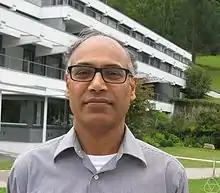V. Kumar Murty
Vijaya Kumar Murty FRSC (born 20 May 1956) is an Indo-Canadian mathematician working primarily in Number theory. He is currently the Director of Fields Institute[1](from 2019). Previously he was the department chair in the Mathematics Department at University of Toronto St. George.

Biography
Murty obtained his BSc in 1977 from Carleton University and his PhD in mathematics in 1982 from Harvard University under John Tate.
From 1982 to 1987 he held research positions at the Institute for Advanced Study at Princeton, Concordia University, and the Tata Institute of Fundamental Research. In 1987, he was appointed as Associate Professor at the Downtown campus of the University of Toronto, and 1991 he was promoted to Full Professor. In 2001, he was deputed to the Mississauga campus to serve a two-year term as Associate Chair of Mathematics, and from 2004 to 2007 he served as the inaugural Chair of the newly-created Department of Mathematical and Computational Sciences at the Mississauga campus. Twice he was Chair of the Department of Mathematics at the University of Toronto Downtown campus (2008-2013 and 2014-2017). He is currently the Director of Fields Institute[1] (2019 - current).
He and his brother, M. Ram Murty, have written more than 20 joint papers.[2] In a book edited by Alex Michalos,[3] there is a description of how the Murty brothers learned mathematics in their teens.
Research and Awards
With almost 40 years of experience in mathematical sciences at the local, national, and global level, Murty’s accomplishments are in diverse areas of analytic number theory, algebraic number theory, information security, and arithmetic algebraic geometry. He has served on the Canadian Mathematical Society Board of Directors, held vice-presidency at the Canadian Mathematical Society, and was elected Fields Institute Fellow in 2003. Murty received the Coxeter–James Prize in 1991 from the Canadian Mathematical Society.[4] He was elected to the Royal Society of Canada in 1995.[5] In 1996, he, along with his brother, M. Ram Murty, received the Ferran Sunyer i Balaguer Prize[6] for the book "Non-vanishing of L-functions and their applications."[7]
In 2018, the Canadian Mathematical Society listed him in their inaugural class of fellows.[8] His dedication is also evidenced through his involvement in the NSERC Undergraduate Summer Research Projects and through his outstanding contributions to the successful GANITA Computational Laboratory, in addition to numerous visiting positions and special lectures.[1]
In 2020, Murty received a $666,667 grant from the Canadian Institutes of Health Research (CIHR) for setting up the COVID-19 Mathematical Modelling Rapid Response Task Force, a network of experts who will work to predict outbreak trajectories for the disease, measure public health interventions and provide real-time advice to policy-makers. It’s one of eight COVID-19 research projects at University of Toronto.[9]
References
- "Professor Kumar Murty is selected as the next Director of the Fields Institute". Fields Institute for Research in Mathematical Sciences. 2019-05-09. Retrieved 2020-12-27.
- List of papers at Mathematical Reviews American Mathematical Society.
- Alex Michalos (editor), The Best Teacher I ever Had, Personal Reports from Highly Productive Scholars, The University of Western Ontario, London, 2003, 290p. ISBN 0-920354-53-X.
- Coxeter-James Prize Coxeter-James Prize, Canadian Mathematical Society.
- Search page on Royal Society Home Page.
- The Ferran Sunyer i Balaguer Prize Retrieved 2019-01-02.
- M. Ram Murty and V. Kumar Murty (1996). Non-vanishing of L-functions. Springer Science & Business Media/Birkhäuser. p. 196. ISBN 978-3-0348-0273-4.
- Canadian Mathematical Society Inaugural Class of Fellows, Canadian Mathematical Society, December 7, 2018
- "Nine U of T researchers — including Math's Vijaya Kumar Murty — receive federal grants for COVID-19 projects". Faculty of Arts & Science. 2020-04-01. Retrieved 2020-12-27.
External links
- Vijaya Kumar Murty: Home Page—University of Toronto, Department of Mathematics.